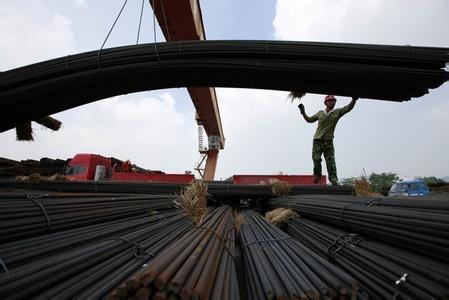(单词翻译:单击)
Even as Japan and the EU embark on fresh rounds of quantitative easing to ward off deflation, the People’s Bank of China is holding the line against major stimulus.
就在日本和欧盟(EU)推出新一轮量化宽松政策以防范通缩之际,中国央行(PBoC)却在与大规模刺激划清界限。
China’s central bank is resisting a rising chorus appealing for more aggressive easing to arrest a slowdown in the economy. Instead it is taking a gritted-teeth approach that accepts short-term pain as the price of structural reform that will support sustainable long-term growth.
中国央行正抵制日益高涨的要求推出更大规模宽松政策(以遏制经济增速放缓)的呼声,反而正咬紧牙关,将短期痛苦视为实施结构性改革要付出的代价,这一改革将支撑长期可持续增长。

At first glance calls for easing in China appear justified.
乍一看,中国要求宽松政策的呼声是合理的。
Consumer price inflation remained mired near a five-year low in October, while the government’s purchasing managers’ index hit a five-month low. That followed growth in economic output in the third quarter that was the slowest since the financial crisis.
中国10月消费者物价通胀(CPI)指数徘徊在5年低点附近,同时中国政府的采购经理人指数(PMI)触及5个月低点。此前,今年第三季度,中国经济产出创下自金融危机以来的最慢增速。
Yet a year after the Communist party revealed a landmark economic reform blueprint, the PBoC wants to avoid steps that would be viewed as undermining the effort to reduce the economy’s reliance on debt and investment.
然而,在中国共产党提出里程碑式的经济改革蓝图一年后,中国正努力降低其经济对债务和投资的依赖,中国央行希望其举措不会被视为会破坏这一努力。
“The central bank has become wary of using its traditional monetary tools like cuts in the required reserve ratio and benchmark interest rates. They’ve basically shelved them,” says Wang Yingfeng, investment director at Shanghai Yaozhi Asset Management, which runs a bond fund.
上海耀之资产管理中心(Shanghai Yaozhi Asset Management)投资总监王影峰表示:“央行对利用降低存款准备金率和基准利率等传统货币工具感到担忧。他们基本上没有考虑这些举措。”该公司管理着一只债券基金。
The shifting approach is in part a matter of style over substance.
这种战略的变化从一定程度上来讲是形式大过实质。
Even as it held off on a reserve ratio cut, in September and October the PBoC injected Rmb770bn ($125bn) into the banking system via a new monetary policy tool called the Medium-term Lending Facility. That is more money than would have entered the system through a 0.5 percentage-point RRR cut, traditionally the central bank’s main tool for managing the money supply.
在中国央行暂停降准之际,今年9月和10月,中国央行通过一个名为中期借贷便利(Medium-term Lending Facility,MLF)的新货币政策工具向银行业体系注入7700亿元人民币(合1250亿美元)。这一规模超过了将存款准备金率下调0.5个百分点进入银行业体系的资金规模。降准一直是中国央行管理货币供应的主要工具。
But the low-key nature of these fund injections – which went unannounced at the time – allows the central bank to avoid sending a strong easing signal.
但低调的注资举动(当时没有宣布)使中国央行得以避免传递强有力的宽松信号。
“The PBoC can lower actual market rates by injecting liquidity without cutting bank benchmark rates,” Lu Ting, chief China economist at Bank of America-Merrill Lynch, wrote in a note last week. “Cutting rates is perceived as anti-reform and kind of politically incorrect.”
“中国央行可以在不降低基准利率的情况下,通过注入流动性下调实际市场利率,”美国银行-美林(Bank of America-Merrill Lynch)首席中国经济学家陆挺上周在一份报告中写道,“降息会被视为与改革相悖,政治不正确。”
Beyond appearances, the use of MLF also gives the PBoC increased flexibility compared to traditional tools.
表象之外,利用中期借贷便利(MLF)还增加了中国央行的灵活性(相对于传统工具而言)。
An RRR cut is viewed as a stronger easing measure in part because it is permanent, unless the PBOC actively reverses it. By contrast, the MLF provides three-month loans to commercial banks. If the PBoC declines to roll the loans over on maturity, the newly created money automatically disappears.
降准之所以被视为更强有力的宽松信号,部分原因是此举是永久性的,除非中国央行主动提高这一比率。相比之下,“中期借贷便利”向商业银行提供了3个月期的贷款。如果央行拒绝在贷款到期后展期,那么这些新制造的货币就自动消失了。
Still, many economists insist a full-fledged rate cut is necessary, noting that increased liquidity in financial markets has failed to lower borrowing costs in the real economy, especially for smaller companies.
然而,很多经济学家坚称,全面降息是必要的,他们指出,金融市场流动性增加未能降低实体经济的借款利率,特别是对于较小企业而言。
“The recent fall in yields has mainly been reflected in the bond and stock markets. But in the real economy a lot of companies aren’t able to sell bonds. They still rely on bank financing. And banks are wary of risks and charging a premium on loans,” says Cao Yang, macroeconomic analyst at Shanghai Pudong Development Bank.
上海浦东发展银行(Shanghai Pudong Development Bank)宏观经济分析师曹阳表示:“最近收益率下跌主要反映在债券和股票市场上。但在实体经济,很多企业无法发售债券。它们仍依赖银行融资。银行担心风险,对贷款收取更高费用。”
Because bank deposit rates in China remain subject to a mandatory ceiling, a cut in benchmark deposit rates would lower banks’ cost of funding. In theory, that should guide loan rates lower.
由于中国银行存款利率有上限限制,降低基准存款利率将降低银行融资成本。从理论上来说,这应会引导贷款利率下滑。
Yet a slowing and economy and rising defaults have made banks cautious about lending to smaller firms, except at high rates.
然而,经济放缓和违约数量增加让银行对借贷给较小企业持谨慎态度,除非是高利率贷款。
The rising risk premium is visible even in the bond market, where yields on highly rated paper have fallen because of PBoC cash injections, while spreads against lower-rated bonds have risen.
日益上升的风险溢价甚至在债券市场也很明显,由于央行注资,高评级的债券收益率一直下滑,其与评级较低的债券的利差一直上升。
In this environment, a rate cut risks channelling even more funds to larger borrowers who are already flush with cash, while small companies still struggle to access finance.
在这种环境下,降息可能会让更多资金流向规模较大、资金已然充沛的借款者,而小企业仍难以获得融资。
“The loan market is fractured,” says Mr Wang. “Banks have a lot of money and they want to lend it, but only to companies they think are safe. But these companies don’t need money. Meanwhile, other companies really need funds can’t get them.”
“贷款市场出现分化,”王影峰表示,“银行拥有大量资金,它们希望放贷,但只贷款给那些它们认为安全的企业。但这些企业不需要资金。与此同时,其他真正需要资金的企业却无法获得资金。”


